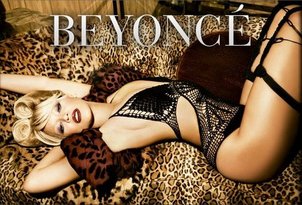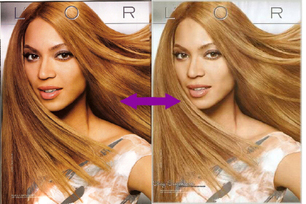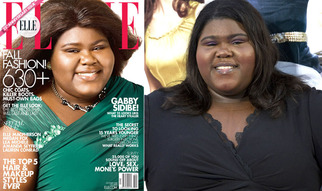


 Last week, singer and actress Beyonce` was caught in the middle of yet another controversy about skin-color airbrushing in media when a new promotional photo for her album ‘4’ surfaced (to the left, no pun intended). Suspecting that her complexion was lightened, some journalists and blog readers accused the singer of lacking racial pride and the company who released the photos of racism and bias. The response was similar in the first controversy over a 2008 L’Oreal Feria advertisement. I have much to say about this. First, I don’t feel that the ‘4’ photo was altered, but the issue of skin-lightening in media is a very real issue. Second, if we want to combat racial bias in media, attacking the celebrity in question is not the answer. In most instances, celebs have NO control over the editing of company advertisements and photographs. It makes more sense to hold the BUSINESSES accountable.  Beyonce's 2008 L'Oreal Feria ad: Racism? In an effort to make everything appear seamless and perfect, printed photo media uses technology to delete blemishes, cellulite and other perceived flaws. Thighs get thinned, breasts are enlarged and hips get sucked in. Many organizations for women and girls assert public images, especially those in beauty/fashion magazines, set an unrealistic standard of beauty that can lead to insecurity, eating disorders or plastic surgery addiction. Skin-color airbrushing, a sign of racial and cultural bias, can lead to a different set of image issues. In American society, European and/or Caucasian descent dominates; therefore everything in American mainstream is based on Caucasian cultural patterns, values and beliefs. In application to defining attractiveness, it is the same. The features of racial minorities are viewed as less attractive or pale in comparison. Subsequently, models of color are far less used in advertisements (unless they are well-known celebrities like Beyonce`) or their features are altered. Elle Magazine came under fire twice after covers of actresses Gabourey Sidibe and Aishwarya Rai appeared to be lightened. In a February 2008 “Glamour” magazine panel discussion on race and beauty, celebrity makeup-artist Mally Roncal stated “I work with celebrity clients at video shoots and on album covers and I’ve had execs say, ‘Can we just soften the ethnicity a little bit?’”  Gabourey Sidibe's lighter 'Elle' cover (2010) This rejection and devaluing of ethnic features in media can cultivate or influence self-image, self-resentment, cultural denial or cultural identity issues in women of color. In Asian-American culture, eye-slant removal surgery is a hot-button issue as women who seek the surgery are charged with changing a prominent ethnic feature to “look more white.” In the black community, chemical hair processes to straighten naturally curly or thicker tresses are viewed by some as assimilationist. Within both the Latino and black populations, discussions about external and internal favoritism towards lighter-skinned individuals are a regular occurrence. Part of the results of a 2010 CNN study with elementary-school children about racial image perceptions revealed that minority children prefer to have a lighter-complexion and feel adults dislike dark skin. Beauty products and magazines are designed for and targeted to women, but arguably does them more of a disservice. Products advertised to men display exaggerated and prejudicial attractiveness standards as well, affecting how we all view and evaluate ourselves and each other. Write to offending companies and state your grievances. Protest by spreading the word and withholding your financial support. We have a choice in what our media feeds us. For more information on how to fight negative gender media, visit MissRepresentation.org.
0 Comments
Leave a Reply. |
Society/CultureMy personal commentary on politics, race, gender, religion, social class, news media and several other things related to our society and culture. Archives
May 2014
Tags/Categories
All
|